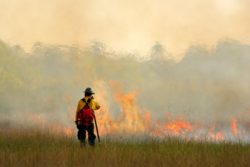 In the wake of a series of devastating wildfires in California, homeowners in the 2019 California wildfires area face another problem: the availability of home insurance may be greatly reduced.
In the wake of a series of devastating wildfires in California, homeowners in the 2019 California wildfires area face another problem: the availability of home insurance may be greatly reduced.
A similar effect was seen on home insurance after the wildfires that happened in 2017 and 2018 in The Golden State. As a result, the renewals of tens of thousands of home insurance policies have been declined in high-risk areas. For those whose policies were not denied, the cost likely went up considerably.
There are currently several wildfires blazing right now in Southern California, and more occurred earlier this year, so 2019 may be heading in the direction of recent years where homeowners insurance will become both more scarce and more expensive.
For a long time, wildfires have only been considered a secondary peril; though they do occur, the insurance industry has expected that they would do no more than a few billion dollars in damage.
When compared with hurricanes and earthquakes, which can cause tens of billions of dollars in damage and are considered primary perils, wildfires have seemed far less of a risk. But this attitude has been changing in recent years.
Indeed, reinsurers (the companies that sell insurance to insurers in the first place) are now taking wildfire risk into serious consideration and will likely continue to raise the costs in any high-risk California wildfires area according to the Wall Street Journal. For those who have already suffered losses due to a recent wildfire, those costs will still go up.
“There’s a lot of areas that have gone from being difficult to insure to just basically impossible,” said Timothy Gaspar, chief executive of Gaspar Insurance Services in California told the Wall Street Journal. “It is something that’s going to continue to get worse.”
According to Wall Street Journal reporters, one California couple recently bought a five-bedroom house in Grass Valley and initially had an annual homeowner’s insurance policy of $2,350. But this year, when they attempted to renew their insurance policy, they received a non-renewal notice.
Eventually, after looking at several different insurance companies, they finally received an insurance quote—reportedly for an $18,000 policy.
According to the Wall Street Journal, the couple went through the California FAIR Plan, which has a lower cost, but doesn’t cover nearly as much and has a maximum limit of $1.5 million on homes. Some homeowners end up choosing to take the risk and go without insurance instead, rather than pay for an insurance policy they can’t afford.
The significant hike in cost is due to how expensive it has gotten for insurers to cover damage from California wildfires, notes the Wall Street Journal. Total claims for the November 2018 California wildfires alone have reached upwards of $12 billion in insured damage, according to the California Department of Insurance.
If you were affected by one of the recent California wildfires, the deadline for making Pacific Gas and Electric California fire claims has unfortunately passed, but there may still be legal options going forward. Consulting an attorney can help you determine if you have a claim, navigate the complexities of litigation, and maximize your potential compensation.
The Thomas Fire was the largest wildfire in California history. It lasted for more than a month and burned almost 300,000 acres.
It destroyed more than 1,000 structures and damaged hundreds more. Besides buildings, the Thomas Fire also destroyed landscaping, trees, fencing, and vegetation.
While the full value of homes and buildings are typically covered by property insurance policies, landscape and trees are not. Only about 5% of insurance policies are typically allocated for tree damage. But many of the properties destroyed by the Thomas Fire included very old and mature trees that provide enormous value as well as usefulness to the property.
Compensation for old-growth trees typically falls below its value. However, you should receive fair compensation for both property and tree damage.
Overview: Thomas Fire Damage
The Thomas Fire started on Dec. 4, 2017, and took more than a month for it to be contained on Jan. 12, 2018. It began just south of Thomas Aquinas College in Santa Paula, California in Ventura County and spread from there, reaching Santa Barbara County. The fire was named after the college.
The estimated cost of damage by the wildfire is more than $2.2 billion.
If your property was damaged or destroyed in the Thomas Fire, you may be entitled to receive compensation for the following damages:
- Structures/Building: If property owners plan to restore the property that was destroyed, homeowners should receive the pre-fire value in addition to funds to pay for upgrades to bring the property up to code.
- Landscaping/Trees: Destroyed landscaping and old trees are often under-insured, but old growth mature trees can add significant value to a property and may qualify for further compensation.
- Fencing: If you’re a rancher or agricultural grower and had fencing that was destroyed, fencing may also qualify for recoverable damages.
- Erosion Control: If vegetation was destroyed that helped prevent erosion around your property, such damage may also qualify for compensation. If not properly repaired, such erosion damage can lead to dangerous mudslides down the road.
You may also qualify for damages for personal property, emotional distress, mental anguish, injuries, death, business income loss, agricultural loss, and other related damages.
Thomas Fire Sparked by Southern California Edison Equipment
Southern California Edison released a statement on Oct. 30, 2018 saying that its equipment sparked at least one of the starting points that started the Thomas Fire.
“Witnesses have reported that a fire ignited along Koenigstein Road near an SCE power pole, and SCE believes that its equipment was associated with this ignition,” the statement said.
Edison has already been hit with Thomas Fire lawsuits.
Join a Free California Wildfire Property Damage Lawsuit Investigation
If you or a loved one suffered property damage in the Camp Fire, Woolsey Fire, Hill Fire or last year’s Thomas Fire, legal help is available to help you through the claim process with your insurance company.
This article is not legal advice. It is presented
for informational purposes only.
ATTORNEY ADVERTISING
Top Class Actions is a Proud Member of the American Bar Association
LEGAL INFORMATION IS NOT LEGAL ADVICE
Top Class Actions Legal Statement
©2008 – 2026 Top Class Actions® LLC
Various Trademarks held by their respective owners
This website is not intended for viewing or usage by European Union citizens.
Get Help – It’s Free
Join a Free California Wildfire Property Damage Lawsuit Investigation
If you qualify, an attorney will contact you to discuss the details of your potential case at no charge to you.
PLEASE NOTE: If you want to participate in this investigation, it is imperative that you reply to the law firm if they call or email you. Failing to do so may result in you not getting signed up as a client or getting you dropped as a client.
E-mail any problems with this form to:
[email protected].
Oops! We could not locate your form.












